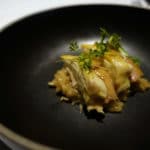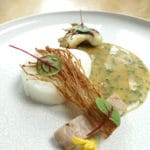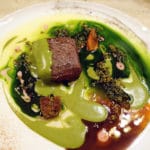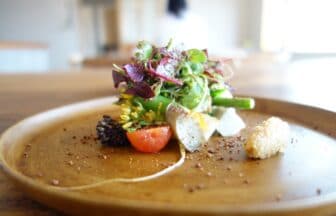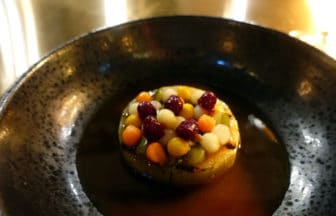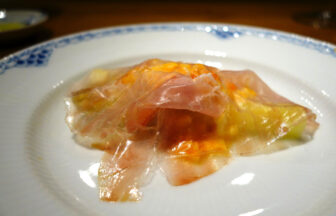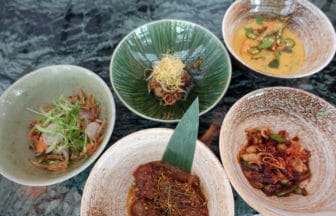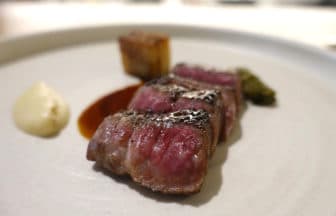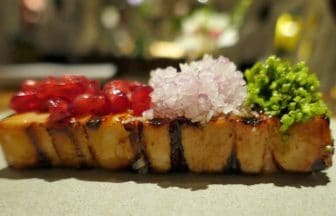Despite being a Michelin one-star restaurant, I discovered the hidden restaurant “Lavilin” that was difficult to grasp its reality.
They thoroughly focus on locally sourced ingredients in Singapore and creatively elevate the food culture enjoyed by the people living here, from street food to Hainan chicken rice and chili crab.
For innovative foodies visiting from overseas, it might be a one-of-a-kind restaurant.
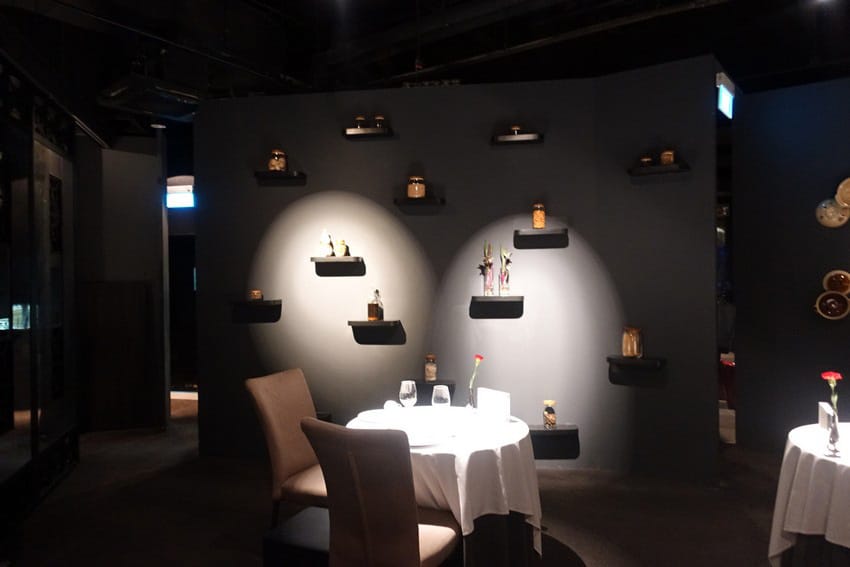
Ave. Budget: Lunch course 208++SGD, Dinner course 298++SGD / “Michelin Guide Sigapore 2022″ 1-star, “Asia’s 50 Best Restaurants 2022” No.40
Stable and innovative cuisine using Singaporean ingredients with outstanding taste and skill.
In Asia, while innovative restaurants that create creative cuisine while respecting their roots have been explored, there are still amazing places to be found.
One such place that I was recently surprised by is “Ravilence” in Singapore.
Although it has been awarded one star in the “Michelin Guide Singapore” for the past few years, its existence was known but it did not really become a topic of discussion, so I wasn’t quite sure what kind of restaurant it was.
I should have realized its true nature sooner.
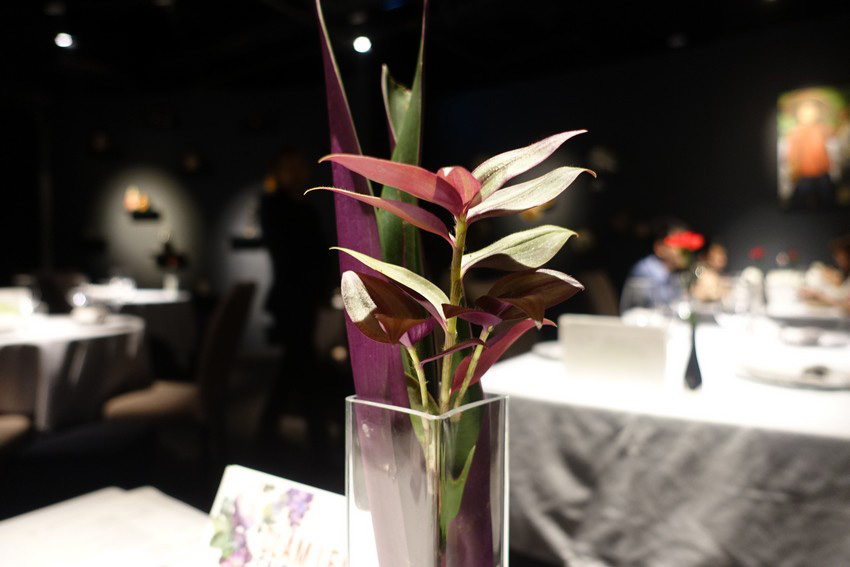
I had previously thought that it was difficult to establish a unique food culture identity in Singapore, and therefore, it would be challenging to establish innovative restaurants.
I considered “Wild Rocket” to be making an effort in the direction of creative Singaporean cuisine, but it was too leaning towards Italian for my taste. In my opinion, the only place that comes close to this direction was “JL Studio” in Taichung.
However, even though their direction was slightly different, “Labyrinth” surprised me.
In a country where imported ingredients were the only option, this restaurant emphasized local ingredients and elevated their dishes through creative ideas and techniques. It was a delightful and surprising discovery.
Restaurant inside the concert hall
The restaurant is located inside the Waterfront Promenade, which is a cultural facility centered around a concert hall, and is located on the second floor.
It’s a two-story restaurant with an entrance that resembles a stylish bar and a chic dining area in the back. You can also use it for a drink or two if you’re meeting someone.
The restaurant is a 10-minute walk away and is directly connected to the City Hall MRT station through an underground tunnel.
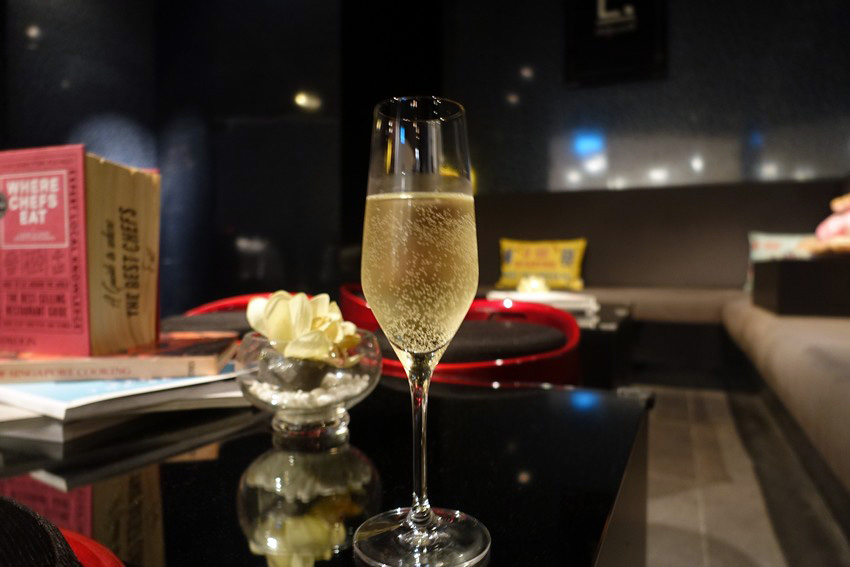
The design of the restaurant, located within the “Waterfront Promenade”, effectively balances open and closed spaces, making use of the two-story structure with a stylish bar at the entrance and a chic dining area in the back.
This is difficult to achieve in a commercial building, as many high-end restaurants often opt to isolate themselves by using walls to change the atmosphere. The thoughtful use of space here impressed me.
The dinner menu consists of only one omakase course.
The menu only consists of the “Chef’s Tasting Menu” for both lunch and dinner.
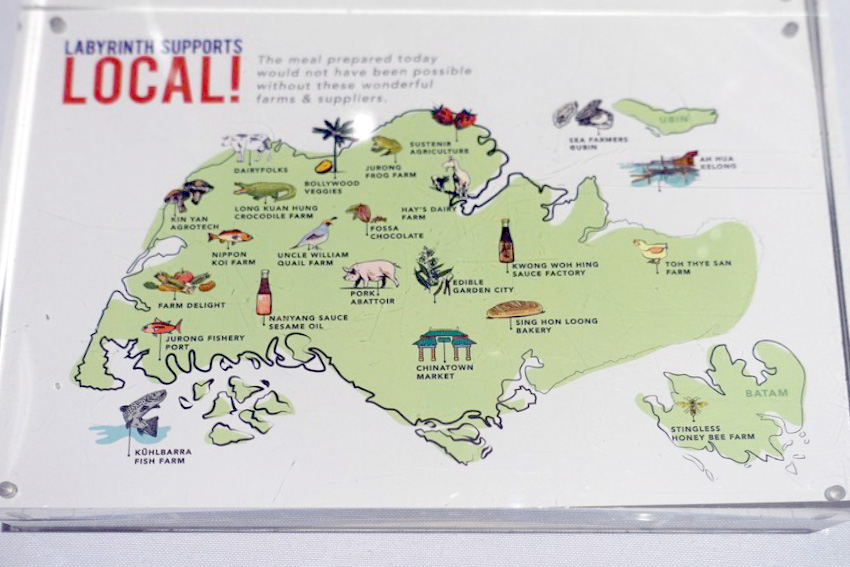
Upon seating, you will first be drawn to the map of the origin of the ingredients.
This is because, in general, maps of Singapore do not focus on areas outside the city center, so this map provides an initial image of what the country looks like.
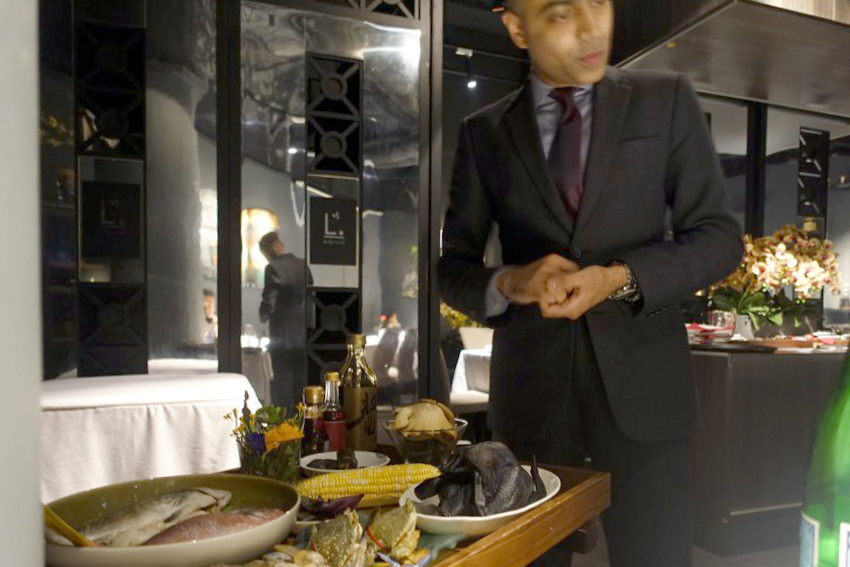
Then, the presentation of the ingredients used on that day is given by the service staff.
I was with a Japanese person who was running a restaurant in the area, and he was surprised to see so much food being produced in Singapore. So, the course starts with the amuse-bouche.
Amuse is a developed type of street food: Part 1 “CHEF’S FAVORITE STREET FOOD”
The first part of the course is titled “The Chef’s Favorite Street Food.”
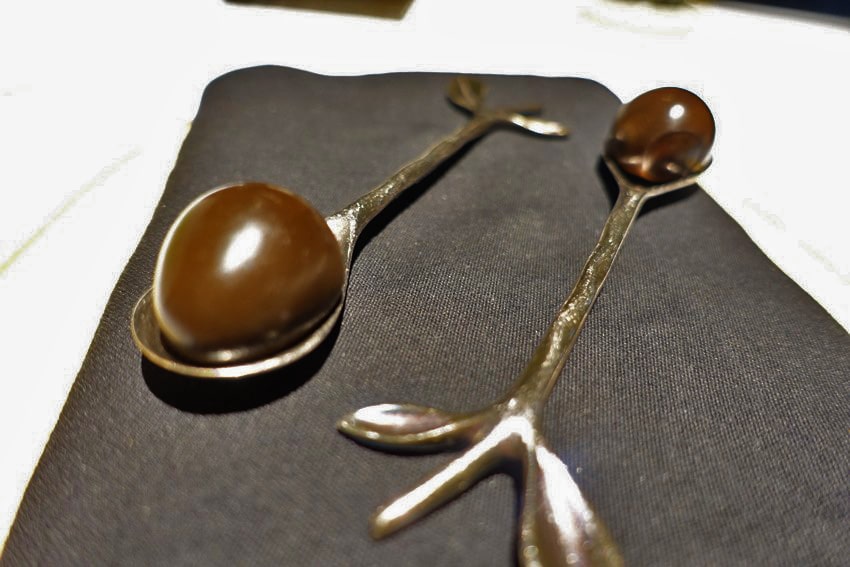
The first dish is “flavored quail eggs.”
Boiled eggs are common at stalls and stalls, but the taste is slightly different from Chinese cuisine and has a Singaporean taste.
Accompanying this is kelp tea.

It’s quite sour.
With these two, your mouth is immediately taken to a foreign feeling.
Furthermore, as the second round of amuse-bouches, the following three items appear one after the other.
‘HEARTLAND WAFFLE’
local chicken liver pate & goji berry jam
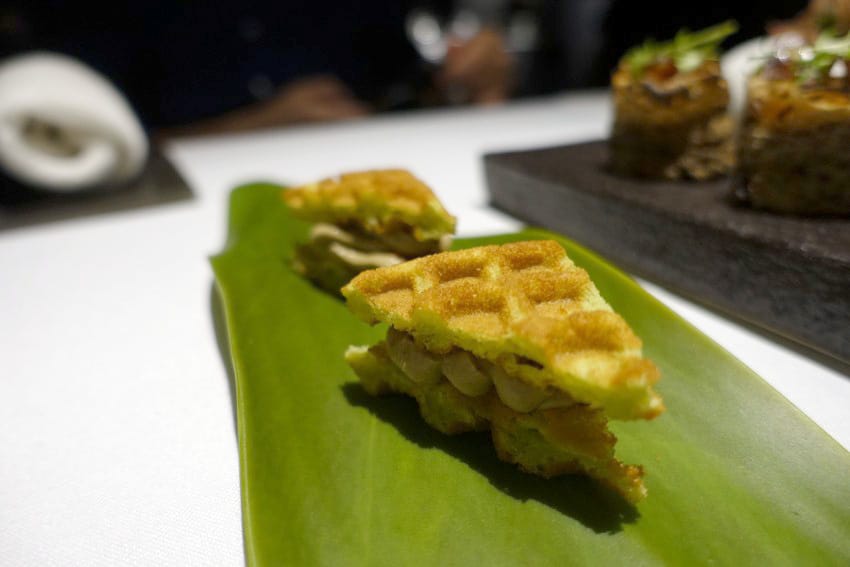
Chicken liver waffle sandwich.
‘HOMEMADE LAPCHEONG’
barley, pickled bak choy, burnt rice “nori”
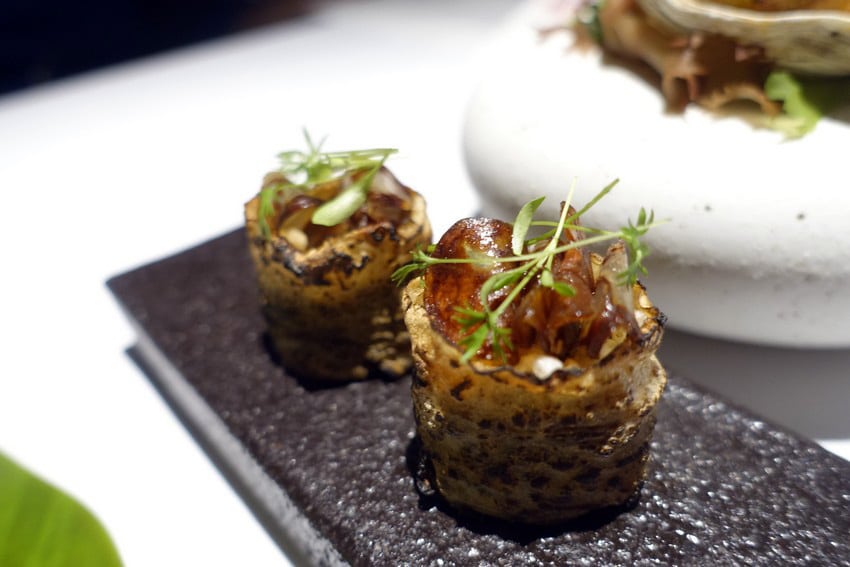
The main ingredient is stuffed intestine “lap cheong.”
It has a grilled okoza feel, with an image like creative sushi.
‘PULAU UBIN OYSTER’
“takoyaki”, sambal & egg floss
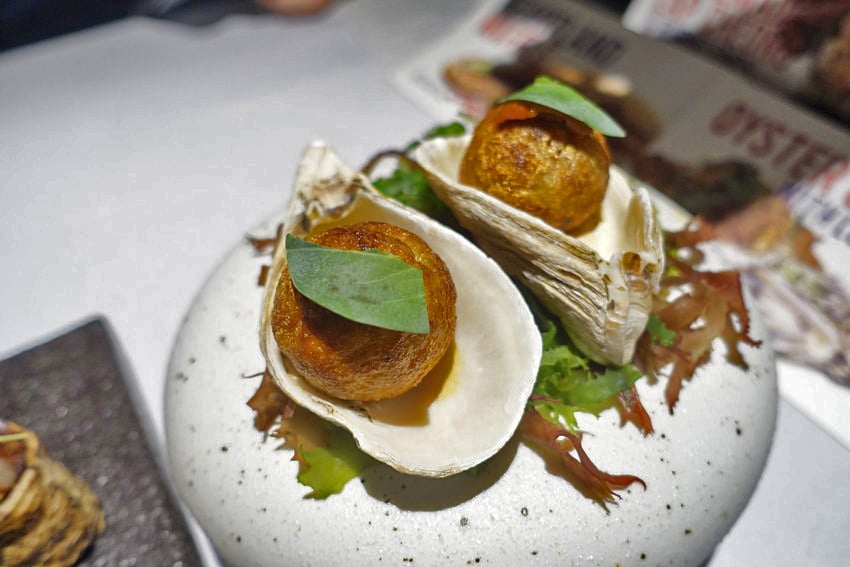
The main ingredient is “lap cheong,” a sausage. It is served in a grilled fashion, reminiscent of creative sushi.
A dish made with oysters caught on Ubin Island is also served, prepared in a takoyaki style.
The menu is presented like a postcard or a paper theater, making it easy for foreigners to understand.
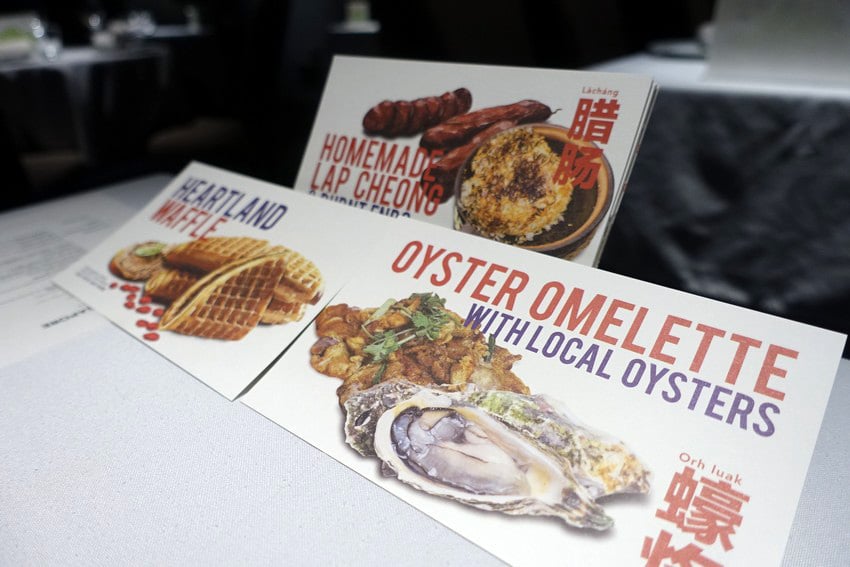
The “Labyrinth” is a restaurant that has been pursuing local food in Singapore with a creative approach since its opening in 2016.
At one point, they attempted to put together a single course that included local food eaten by Singaporeans from breakfast to dinner under the theme of “Singaporean’s 24 hours.”
Despite changing the presentation style, the underlying concept remains unchanged and has stabilized into its current style around the summer of 2018.
Another dish that embodies the restaurant’s passion for local street food is about to come out.
‘AH HUA KELONG LALA CLAMS’
xo sambal, deep fried wonton skin & chinese spinach
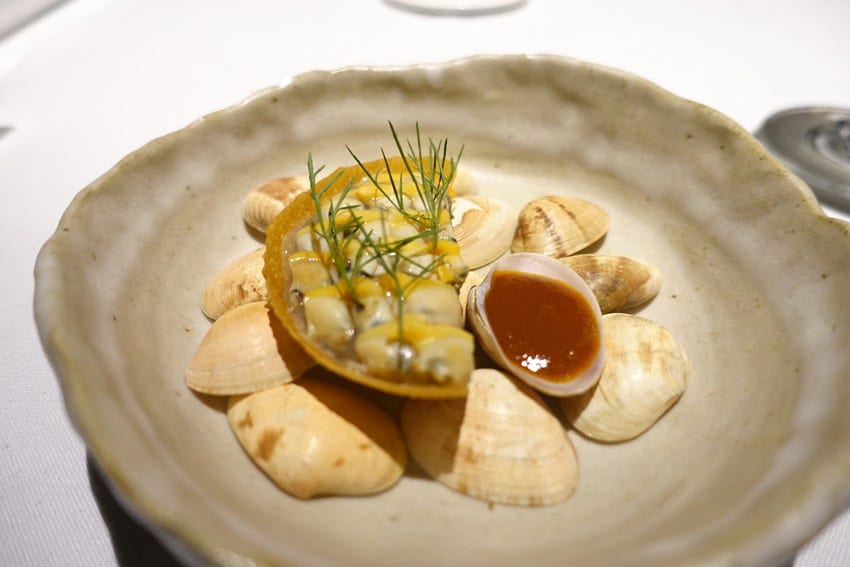
Next, “Lala Clams” that have been set with gelatin and served in a tartare-style dish.
These clams, which are caught locally, are often used for making broth, but are not often used as a main ingredient.
This dish highlights an often overlooked ingredient, showcasing the restaurant’s approach of focusing on local street food.
The original sauce, made by adding XO sauce to sambal sauce, is excellent. Although this sequence of appetizers already provides a good sense of Singapore’s flavors, the course is just starting to reach its climax.
Part 2: “PLATES” sublimated Singapore domestic ingredients
After the street food-style appetizers are finished, the next course is named “PLATES.”
It consists of a sequence of dishes including the traditional starters, main courses of fish or meat, and ending with a rice dish. But what kind of dishes will actually be served?
‘LABYRINTH ROJAK’
Edible Gardens herbs, natural stingless bee honey & jackfruit sorbet
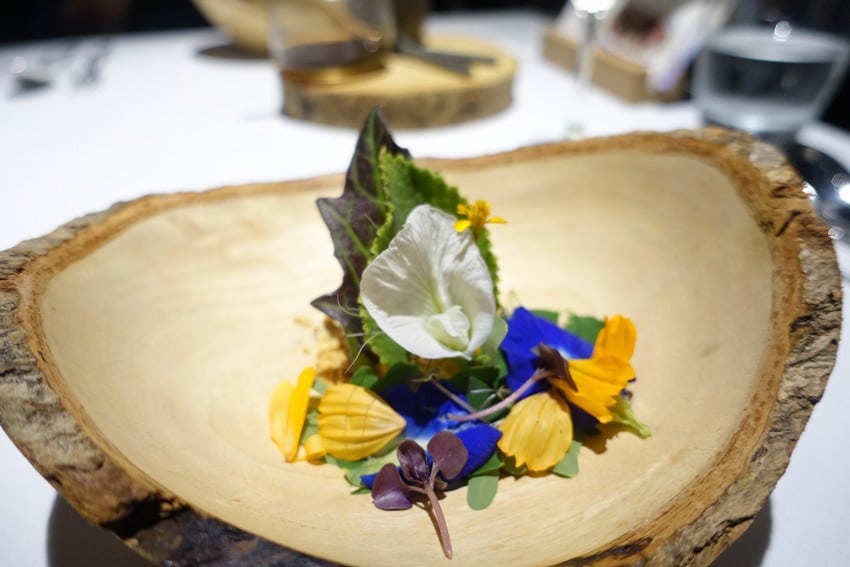
The next dish is a salad made with 10 edible flowers and herbs.
The dressing is made with jackfruit sorbet and honey, which is sourced from Batam Island in Indonesia near Singapore.
‘JURONG FISHRY’
catch of the day
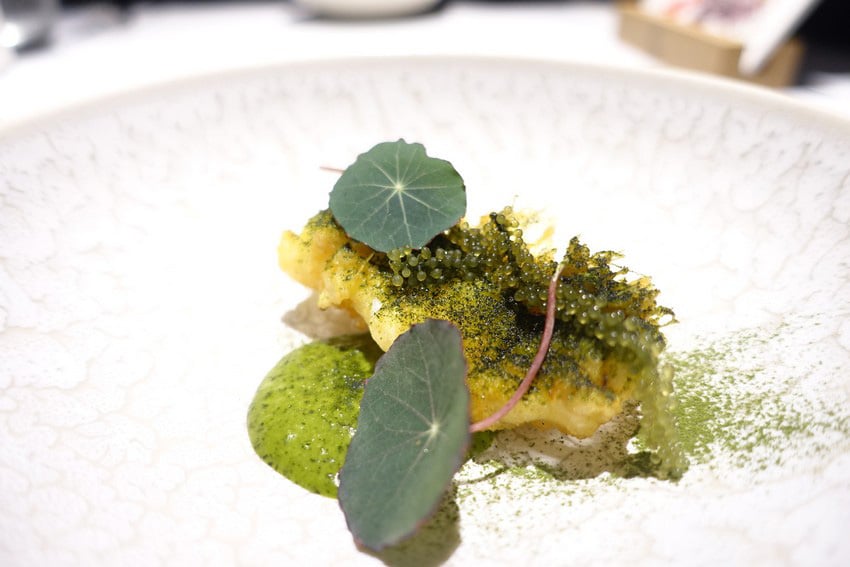
The daily fish dish.
On this day, it was zarigani fried. With a wasabi sauce and seaweed as accents.
‘GRANDMA’S FISH MAW SOUP’
yellow tail snapper fish cake, textures of fish maw & tofu puree
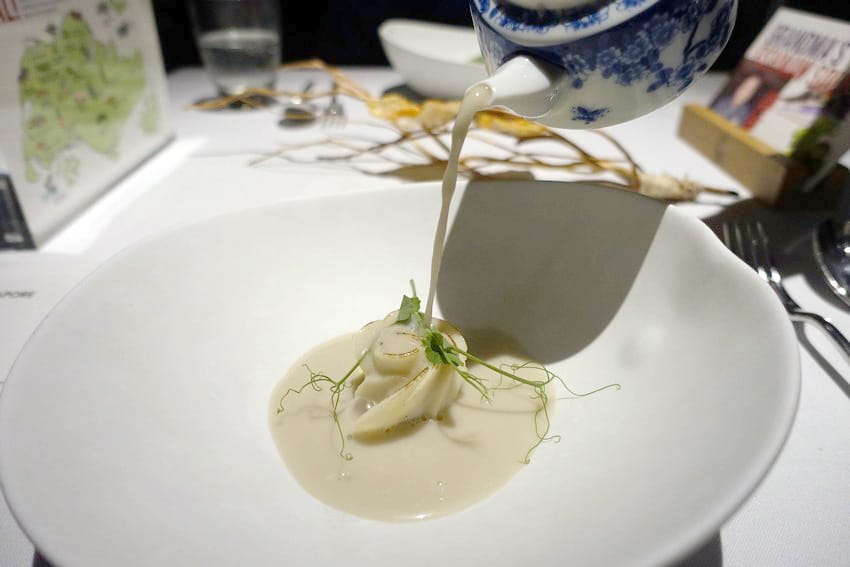
“Fish Maw” refers to the swim bladder of a fish.
It is commonly used in Chinese cuisine as an ingredient in congee, etc., but here it is used as a high-end soup after being cleaned.
The fish body decorated like flowers is a luxurious fish called yellowtail snapper, which belongs to the Perciformes Lateolabrax family.
Although it is not widely available in Japan, a proper Japanese name for it cannot be thought of at the moment.
‘LOCAL WILD CAUGHT CRAB’
signature chili ice cream, egg whites & salted mackere
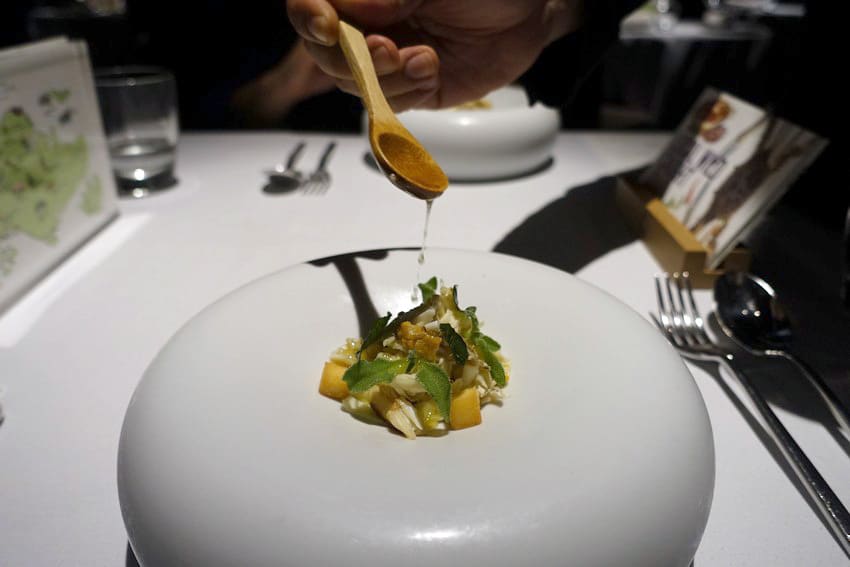
You could say it’s an evolved version of the famous “Chilli Club” in Singapore.
Fresh, locally caught crab is given a new texture with instant freeze-dried chilli powder.
It’s still only the middle of the meal, so what other twists are in store?
‘NIPPON KOI FARM SILVER PERCH “OTAH”
otah rempah, all-spice leaf, kaffir lime oil
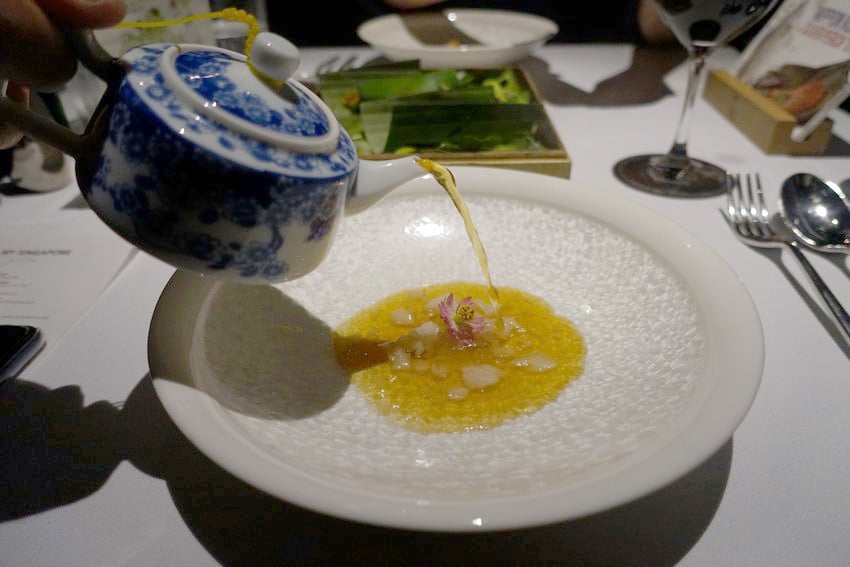
The soup features “SILVER PERCH”, a freshwater fish raised at the “NIPPON KOI FARM” in Singapore that specializes in breeding Koi.
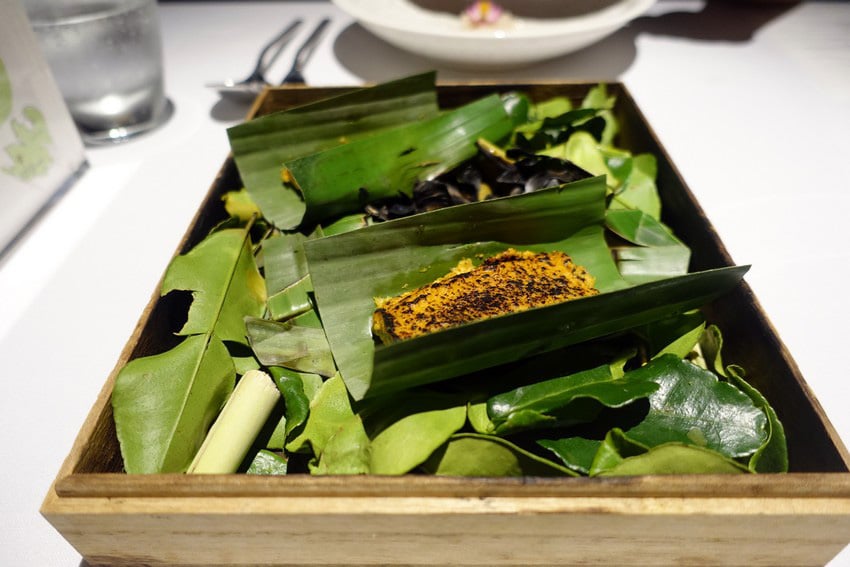
Accompanied by the traditional dish of the Malay Peninsula, “Otah” made by steaming fish flesh with curry paste.
‘SUSTAINABILITY’
“chicken”-“chicken”-chicken satay, muah chee, Mr Anand’s peanut sauce
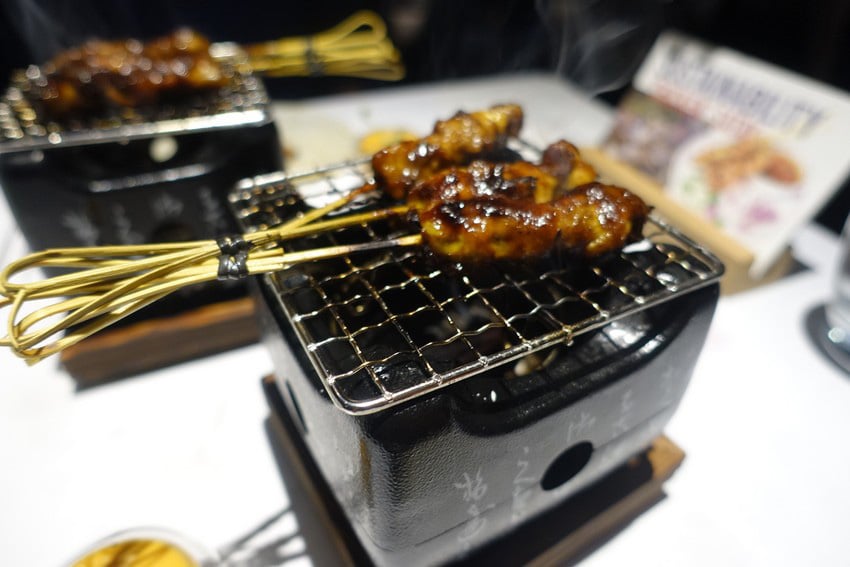
The main meat dish is satay, which is served on a tabletop skewer and is made with charcoal, not solid fuel.
The menu item is called “Bird’s Satay,” and it contains a premium ingredient that is a surprise for diners to discover.
‘CLAYPOT “ANG MOH” CHICKEN RICE’
kampong chicken, local mushrooms, grandma’s chilli sauce

And of course, when it comes to Singapore, it’s got to be “Hainanese Chicken Rice.”
First, the rice is presented to you cooked in a clay pot, and then it’s served individually portioned. The flavor is sophisticated. It’s more like a premium version of “Hainanese Chicken Rice” rather than a reconstructed one.
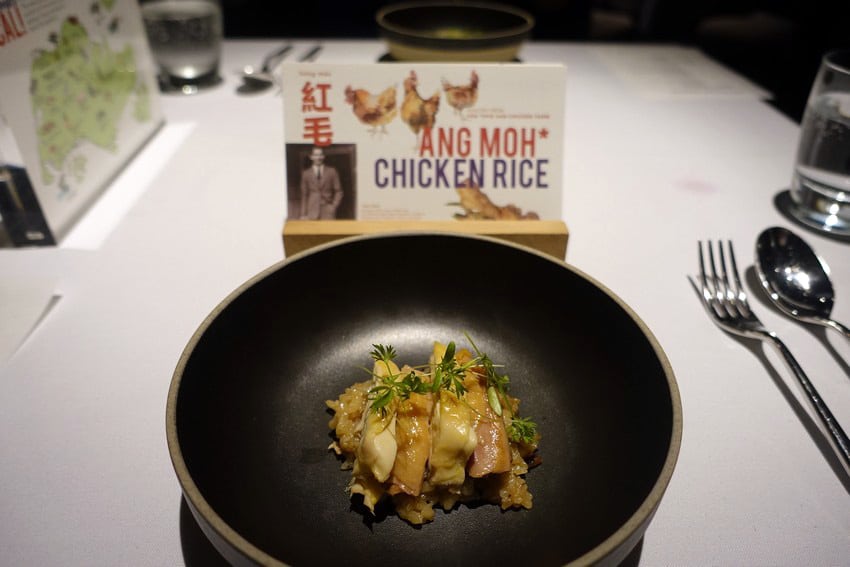
At this point, the satisfaction level of having eaten at “PLATES” had already exceeded 100%, but the desserts were also abundant.
It could be said that they formed one dessert course. Will there be enough room in your stomach for it?
The third part “DESSERT” which seems to be a course by itself
Despite thinking that the information one needs to take in has already been filled to the brim, starting from the appetizer to the main dish, the story still continues.
PRE DESSERT “NATS ABOUT COCO”
house made nata de coco, aloe vera, textures of fresh market coconut
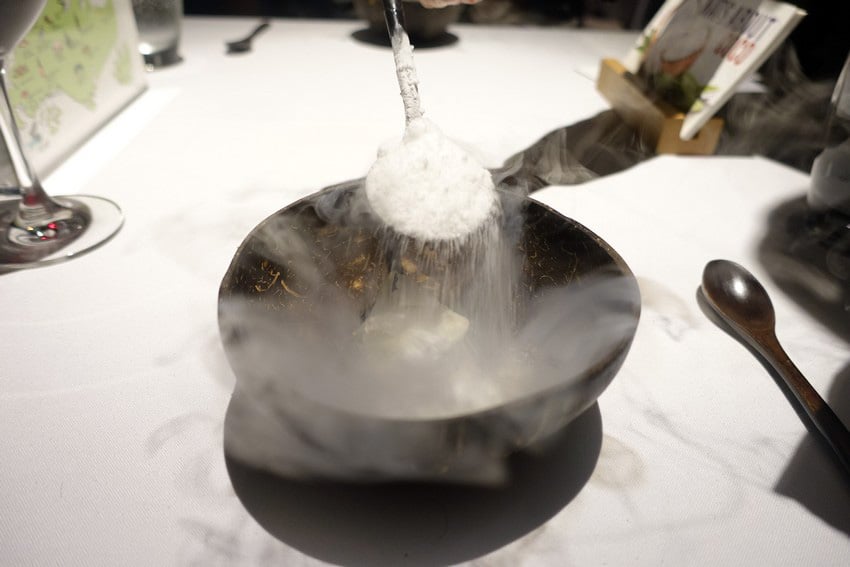
The first dessert is a pre-dessert called “Nata de Coco.” It is purely a “preview.”
The Nata de Coco, made with aloe vera, is topped with a generous amount of coconut powder frozen from the local market.
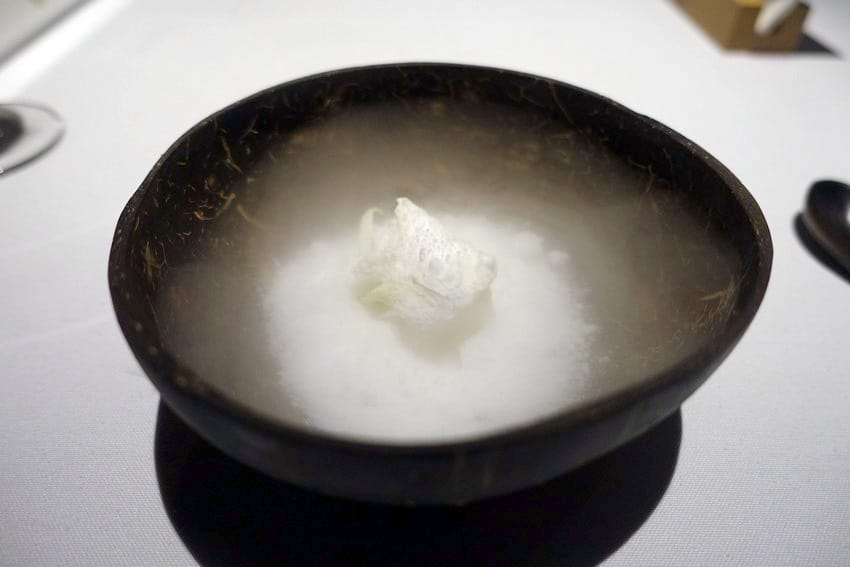
Although I no longer consider liquid nitrogen-based style to be innovative, I am happy with this texture even if it is a classic.
Watching this winter scene in a tropical country is a unique experience.
PALATE CLEANSER “CLAM LEAF SNOW”
local herbs, peach gum & textures of grapes
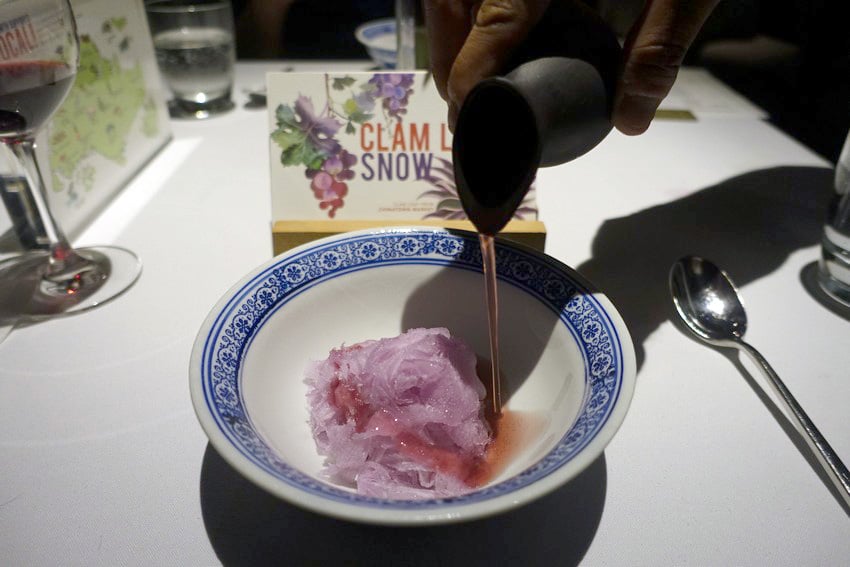
After the pre-dessert, a palate cleanser?
A sorbet mixed with herbs and a rich grape juice syrup-like.
SWEET “SOY BEAN CURD”
local hashima, snow fungus, chrysanthemum
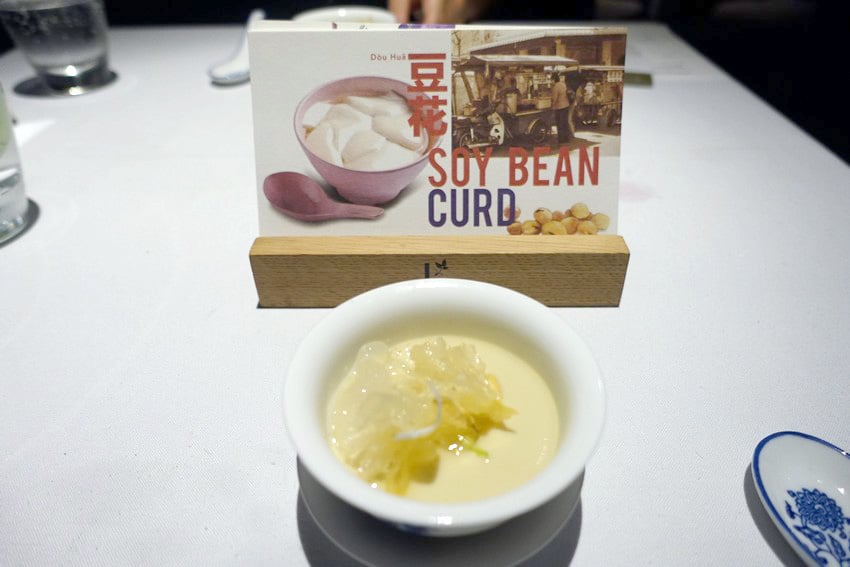
The first dish of the main dessert is soy milk pudding.
It is served with HASHIMA, shirokikurage, and edible chrysanthemum flowers.
SWEET “PASAR MALAM”
local corn, Hay Dairies goat milk butter, gula jawa-salted egg popcorn
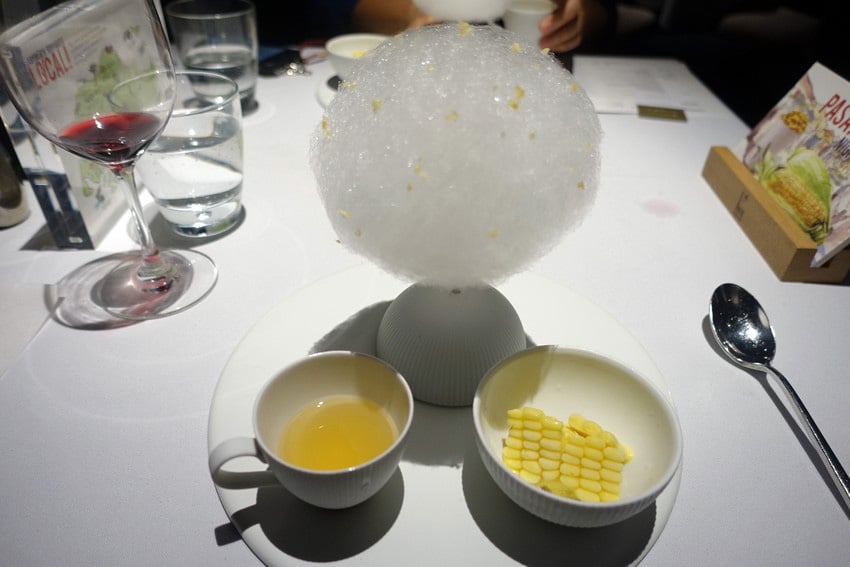
The second main dessert is named “Pasar Malam” and features frozen corn, milk made from goat milk sourced from farms in Singapore, and cotton candy flavored with palm sugar.
PETIT FOURS

Two petit fours are also served.
One is a chocolate confectionary, the other is a cake sandwich with caviar on top.
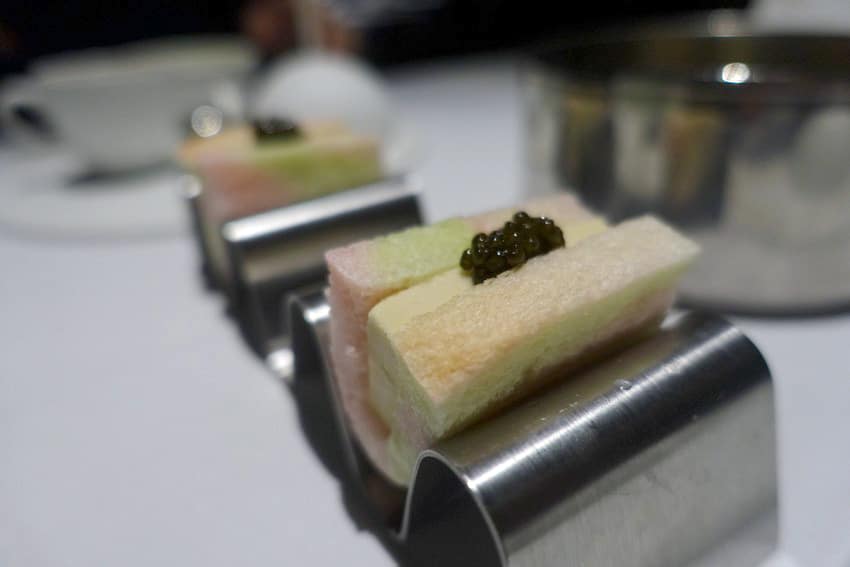
The dessert course consisted of a total of 6 dishes.
Each dish was either a beloved local food or a sophisticated rendition of ingredients produced in Singapore.
The course was well-rounded and kept the diners engaged until the very end.
Summary
The above was an introduction to “Labyrinth” in Singapore, how was it?
I was surprised to know that such a restaurant that revitalizes tradition and innovatively drops it in Singapore exists, and I was impressed by the fact that they have fully utilized Singapore’s local food.
In that sense, if you want to experience “now” in Singapore as a traveler, you can eat various local foods such as Hainanese Chicken Rice, Chilli crab, Sate, etc., so you may think that visiting this restaurant alone is enough.
–Restaurant Information on “Labyrinth”–
Business Hours: Lunch 12:00-14:00, Dinner 18:30-21:30
Holiday: Mon. Lunch on Sat & Sun
Telephone: +65 6223 4098
Address: Esplanade Mall, #02-23, Marina Bay Promenade, 8 Raffles Avenue, Singapore
Official web
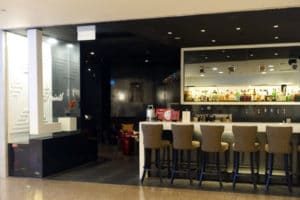
MAP
▽If you’re looking for Michelin-starred restaurants in Singapore, check out this article▽
▽If you’re looking for restaurants ranked in “Asia’s 50 Best Restaurants,” this article is for you▽


